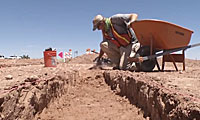Much to be learned from historic site near SR 77
Much to be learned from historic site near SR 77

If you read yesterday’s blog post, you’ve already learned why ADOT gives special attention to culturally or historically significant project areas. So, for today’s post we thought it’d be fun to take an up-close look at an actual site…
As you can see from the video above, there’s an area that was recently excavated and explored. It’s called the Beethoven site and is located about five miles north of Snowflake, off State Route 77.
Ordinarily, an excavation like this would have to wait until ADOT had a highway construction project to work on (lane widening, new freeway construction, etc.) -- that way the cost would be included in the project’s scope.
But this site’s a little different…
It is scheduled for culvert extensions and passing lanes in the future, but because of its close proximity to the highway, the site (and all the history it contains) was starting to become endangered.
“We realized that we were dealing with something special ... more special than the average site,” ADOT Historic Preservation Specialist David Zimmerman said. “We started looking ahead and figuring the long-term affects on the site, from the continued use of the road into the future and the possibility that water or culvert maintenance could damage the site. We made a decision that it was probably best to extend our investigations and do more with that site.”
Luckily a federal grant from FHWA was awarded so ADOT could begin investigations right away.
“It’s been an opportunity to get in there and actually recover a lot of new information … and to find this communal structure is a really big step forward in understanding this time period,” says Desert Archaeology president Bill Doelle in the video above.
According to Zimmerman, the area is one that has been used in the past by the Zuni, Hopi, Apache and Navajo tribes. Among the discoveries at this site: some pit houses, along with a very large communal pit structure.
The structures and artifacts uncovered by crews will provide a lot of valuable information. But, according to Zimmerman, it’s going to take some time to really research all that has been discovered.
There’s still lab analysis, soil testing, artifact cataloging and radio carbon testing to be done, according to Zimmerman. After that, a report will be completed and researchers will be able to draw some conclusions on the site’s history and hopefully get more insight into the way people lived in the area, how they organized themselves and adapted socially and economically to the environment.
“Each site tells a story, but the real knowledge is how each site fits into bigger sites and the bigger area to really grab a pattern of culture,” Zimmerman said.
